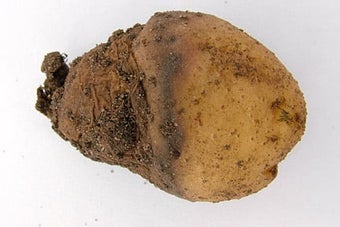
Quick facts
Common name - Black scurf and stem canker
Scientific name - Rhizoctonia solani
Plants affected - Potatoes
Main symptoms - Black scurf raised black patches on the tubers. Stem canker sunken brown lesions on stems
Caused by - Fungus
Timing - Black scurf at harvest in late summer and autumn. Stem canker spring and summer
What is potato black scurf and stem canker?
Black scurf is caused by the fungus Rhizoctonia solani, which can exist in the soil in the absence of potatoes. It does not feed on the tubers, and stored tubers with black scurf on them will not decay or deteriorate. The black marks are readily removed by peeling and scrubbing. However, heavily-affected seed tubers should not be planted, as the tips of the emerging sprouts and later the stems can be attacked by the fungus.
Stem canker is caused by the same fungus, but symptoms appear on the developing shoots instead.
Symptoms
Black scurf is easily recognised:
- Raised, hard, black patches, irregular in size or shape, on the surface of the . These are readily rubbed or scraped off
- Brown strands of fungal material called mycelium can sometimes be seen around the black scurf with the aid of a magnifying glass
- The scurfs themselves are in fact compact masses of fungal mycelium
The fungus can also cause a symptom known as stem canker on potato sprouts (new shoots) and stems:
- Sunken, brown lesions develop on the sprouts before they emerge from the soil
- In severe cases the tip of the sprout is killed. It often shoots again from lower down, but emergence is delayed
- Rough, brown, sunken patches develop on the stem, below soil level
- If these girdle the stem then stunting and wilting often results, sometimes with the production of small, green, aerial tubers in the junction between the stem and leaf stalk

Control
Non-chemical control
- Use seed tubers free of substantial infection
- Practise crop rotation
- Avoid excessively early planting, use seed that has been sprouted (chitted) prior to planting, and water plants in dry periods
- Where stem canker has been a problem previously, consider planting into shallower ridges (to help speed emergence of the shoots from the soil)
- Early lifting will reduce the numbers of black scurfs that form on the tubers
Chemical control
No chemical controls are available to gardeners.
Biology
Rhizoctonia solani is found very commonly in soil, but exists as a number of different strains, not all of which can attack potatoes. Infection can arise from the soil or by the planting of affected seed tubers. The strains that attack potatoes are likely to increase rapidly in the soil if the crop is grown in successive years or in a short rotation. The black scurf is a resting structure of the fungus, known as a sclerotium.
Attacks on the sprouts are usually most damaging if their growth through the soil is delayed by cold, dry weather. Stem canker and black scurf also tend to be more common on lighter soils. Development of black scurf on the tubers increases rapidly as the crop dies down naturally at the end of its growth.



